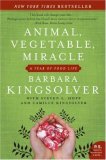Summary | Excerpt | Reading Guide | Reviews | Beyond the Book | Read-Alikes | Genres & Themes | Author Bio

Critics' Opinion:
Readers' Opinion:
First Published:
May 2007, 384 pages
Paperback:
Apr 2008, 400 pages
 Book Reviewed by:
Book Reviewed by:
BookBrowse Review Team
Buy This Book
Please be aware that this discussion guide will contain spoilers!
Introduction
Action Items—On Your Own
Try eating at least one meal per week made from locally and organically
produced meats and produce. As Steven L. Hopp points out in Animal,
Vegetable, Miracle, this "would reduce our country's oil consumption by more
than 1.1 million barrels of oil every week."
To find farmers' markets and local producers in your area, visit the USDA
website at www.ams.usda.gov, or check out
www.LocalHarvest.org and
www.csacenter.org.
When shopping at a grocery store or food co-op, ask about food origins and
request that locally produced items be stocked.
Share your opinion with local and regional policymakers at town and city hall
meetings, school board meetings, and state commissioner meetings. Also, speak up
at venues you or your family frequent where food is served such as a church,
social club, school, or day care center and encourage them to use local
ingredients.
If you have the space, start your own garden and begin by growing a few items.
If you live in an urban area, consider taking part in a community garden (www.CommunityGarden.org).
More information about urban gardening can be found at
www.CityFarmer.org and
www.UrbanGardeningHelp.com.
Share stories about your local food adventures at
www.animalvegetablemiracle.com.
Action Items—With Your Book Club
Take a tour of a local farm, visit a farmers' market, or try your hand at a
u-pick operation (strawberries in the summer, for example, or apples in the
fall).
If you're inclined to take your book club international, follow in Barbara
Kingsolver's footsteps and experience Italy's agriturismo, a guest
accommodation on a working family farm.
For your club's discussion of Animal, Vegetable, Miracle, devise your own
menu or use the recipes in the book to prepare a feast with locally produced
ingredients that are in season.
Alternately, hold your book club discussion at a farmer's diner or a restaurant
that uses local ingredients.
In the spirit of Barbara Kingsolver's 50th birthday festivities, which she
describes in the book, have a plant exchange. (Just don't thank each other for
the blooms!)
Take a class or meet up at a member's home for a session of cheese-, yogurt-, or
bread-making.
Donate to a hunger-relief organization that teaches sustainable farming
practices. Visit www.WN.org (World Neighbors),
www.JourneyToForever.org, or
www.Heifer.org (Heifer International) for
information.
Additional Resources
www.AnimalVegetableMiracle.com—recipes,
web resources, and more
www.Kingsolver.com—listen to an audio
interview with Barbara Kingsolver about Animal, Vegetable, Miracle
Unless otherwise stated, this discussion guide is reprinted with the permission of Harper Perennial. Any page references refer to a USA edition of the book, usually the trade paperback version, and may vary in other editions.





The House on Biscayne Bay
by Chanel Cleeton
As death stalks a gothic mansion in Miami, the lives of two women intertwine as the past and present collide.

The Flower Sisters
by Michelle Collins Anderson
From the new Fannie Flagg of the Ozarks, a richly-woven story of family, forgiveness, and reinvention.

The Funeral Cryer by Wenyan Lu
Debut novelist Wenyan Lu brings us this witty yet profound story about one woman's midlife reawakening in contemporary rural China.
Your guide toexceptional books
BookBrowse seeks out and recommends the best in contemporary fiction and nonfiction—books that not only engage and entertain but also deepen our understanding of ourselves and the world around us.